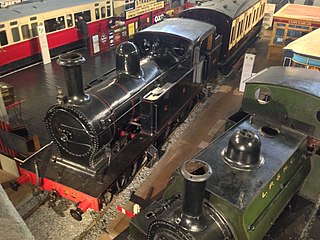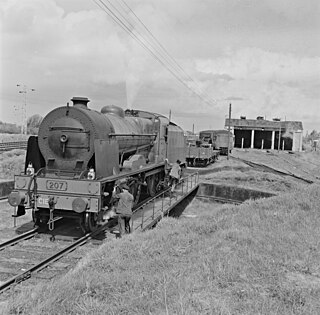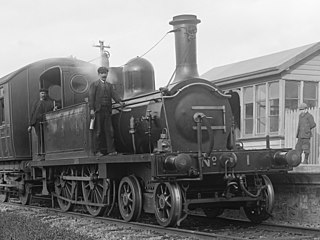
Sir Herbert Nigel Gresley was a British railway engineer. He was one of Britain's most famous steam locomotive engineers, who rose to become Chief Mechanical Engineer (CME) of the London and North Eastern Railway (LNER). He was the designer of some of the most famous steam locomotives in Britain, including the LNER Class A1 and LNER Class A4 4-6-2 Pacific engines. An A1 Pacific, Flying Scotsman, was the first steam locomotive officially recorded over 100 mph in passenger service, and an A4, number 4468 Mallard, still holds the record for being the fastest steam locomotive in the world (126 mph).

The Great Northern Railway V class steam locomotives were 4-4-0 three-cylinder compound locomotives built in 1932 by Beyer, Peacock & Company for the Great Northern Railway (Ireland).

The Great Northern Railway (GNR) Small Boiler Class C1 is a class of steam locomotive, the first 4-4-2 or Atlantic type in Great Britain. They were designed by Henry Ivatt in 1897. In total 22 were built between 1898 and 1903 at Doncaster Works. The class were commonly known as 'Klondykes' [sic], after the 1897 Klondike gold rush. They could reach speeds of up to 90 mph. They were also known as Small Atlantics.

The Midland Great Western Railway (MGWR) was the third largest Irish gauge railway company in Ireland. It was incorporated in 1845 and absorbed into the Great Southern Railways in 1924. At its peak the MGWR had a network of 538 miles (866 km), making it Ireland's third largest network after the Great Southern and Western Railway (GS&WR) and the Great Northern Railway of Ireland.
This is a bibliography for the history of rail transport in Ireland.

The Great Northern Railway (Ireland) (GNR(I) or GNRI) was an Irish gauge (1,600 mm (5 ft 3 in)) railway company in Ireland. It was formed in 1876 by a merger of the Irish North Western Railway (INW), Northern Railway of Ireland, and Ulster Railway. The governments of Ireland and Northern Ireland jointly nationalised the company in 1953, and the company was liquidated in 1958: assets were split on national lines between the Ulster Transport Authority and Córas Iompair Éireann.

The Great Northern Railway of Ireland (GNRI) AEC Class were Associated Equipment Company (AEC)–engined diesel multiple units that operated InterCity and suburban services on the GNRI and later Ulster Transport Authority (UTA) systems between 1950 and 1975. They were finally withdrawn in 1972. They were the inspiration for the CIÉ 2600 Class.

The GNR(I) Q Class 4-4-0 steam locomotives of the Great Northern Railway (Ireland) (GNR) were mainly used on cross-border mixed traffic duties between Dublin and Belfast, as well as the "Derry Road" between Portadown and Derry. It was designed for the GNR under the auspices of Charles Clifford and built by Neilson, Reid and Company, North British Locomotive Company and Beyer, Peacock and Company. The Q Class is slightly smaller than the GNR class S 4-4-0 but powerful enough to haul a rake of eight or more carriages.

The GS&WR Class 101, classified as Class 101 or Class J15 by the Great Southern Railways, was a class of 0-6-0 steam locomotives designed for working goods traffic although they did, and were quite capable of, working branch and secondary passenger trains.

Dublin and Drogheda Railway (D&D) was a railway company in Ireland which publicly opened its 31¾ mile main line between Dublin and Drogheda in May 1844. It was the third railway company in Ireland to operate passenger trains and the first to use the Irish standard 5 ft 3 in gauge. It later opened branches to Howth and Oldcastle. The opening of the Dublin and Belfast Junction Railway (D&BJct) between the D&D at Drogheda and the Ulster Railway (UR) at Portadown in 1852 saw an almost continuous main line connection between Dublin and Belfast, which was resolved by the official opening of the Boyne Viaduct in April 1855. Amalgamations between these and other companies in 1875 and 1876 saw the creation of the Great Northern Railway of Ireland GNR(I).

The Great Northern Railway (Ireland) class S was a class of five 4-4-0 steam locomotive that the Great Northern Railway introduced in 1913 to haul Belfast – Dublin express passenger trains. They were followed two years later by the three similar class S2 locomotives.

The Bury Bar Frame locomotive was an early type of steam locomotive, developed at the Liverpool works of Edward Bury and Company, later named Bury, Curtis, and Kennedy in 1842. By the 1830s, the railway locomotive had evolved into three basic types - those developed by Robert Stephenson, Timothy Hackworth and Edward Bury.

The Great Northern Railway (Ireland) SG and SG2 classes was one of the last designs of Charles Clifford. They were primarily intended for goods work, but the increased wheel diameter enabled effective passenger duties, managing heavy excursion trains with ease and speed.

The GNR(I) class U was a class of 4-4-0 steam locomotives built for the Great Northern Railway (Ireland).

The Great Northern Railway (Ireland) JT class comprised six 2-4-2T locomotives, all built between 1895 and 1902 at their Dundalk Works. These were of a J. C. Park design, but introduced following his death. They were used on Dublin suburban services; then on branch lines, including operation of the Dundalk, Newry and Greenore Railway when taken over in 1933. Most were withdrawn shortly after 1955 between 1955 and 1957 but one remained passed to Córas Iompair Éireann (CIÉ) and remained in service until 1963.

The Great Northern Railway (Ireland) (GNRI) VS class steam locomotives were 4-4-0 three-cylinder simple expansion steam locomotives built in 1948 by Beyer, Peacock and Company. They were procured in order to operate the Enterprise train service between Dublin and Belfast and were the last series of steam engines ordered by the company.
Great Northern Railway Classes PG, QG, QLG and QNG were a series of 0-6-0 freight locomotives introduced from 1899 by Charles Clifford.
Great Northern Railway Class P were two sets of 4-4-0 locomotives for the Great Northern Railway of Ireland (GNRI) introduced from 1892 by locomotive superintendent J.C. Park; four having 6 ft 7 in (2.01 m) driving wheels and eight having 5 ft 7 in (1.70 m) driving wheels. Park was succeeded by Charles Clifford who constructed 17 broadly similar locomotives from 1896 with 6 ft 7 in (2.01 m) driving wheels; these were designated Class PP. The last PP class survived until 1963.

Great Northern Railway Class BT were a class of 13 4-4-0T tank locomotives introduced by the GNR(I) from 1885.
Robert Coey (1851–1934) was a locomotive superintendent of the Great Southern and Western Railway (GS&WR) of Ireland from 1896 until 1911.















